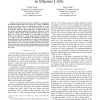Free Online Productivity Tools
i2Speak
i2Symbol
i2OCR
iTex2Img
iWeb2Print
iWeb2Shot
i2Type
iPdf2Split
iPdf2Merge
i2Bopomofo
i2Arabic
i2Style
i2Image
i2PDF
iLatex2Rtf
Sci2ools
78
Voted
INFOCOM
2007
IEEE
2007
IEEE
Using Low-Power Modes for Energy Conservation in Ethernet LANs
—Most Ethernet interfaces available for deployment in switches and hosts today can operate in a variety of different low power modes. However, currently these modes have very limited usage models. They do not take advantage of periods of inactivity, when the links remain idle or under-utilized. In this study, we propose methods that allow for detection of such periods to obtain energy savings with little impact on loss or delay. We evaluate our methods on a wide range of real-time traffic traces collected at a high-speed backbone switch within our campus LAN. Our results show that Ethernet interfaces at both ends can be put in extremely low power modes anywhere from 40%-98% of the time observed. In addition, we found that approximately 37% of interfaces studied (on the same switch) can be put in low power modes simultaneously which opens the potential for further energy savings in the switching fabric within the switch.
| Added | 03 Jun 2010 |
| Updated | 03 Jun 2010 |
| Type | Conference |
| Year | 2007 |
| Where | INFOCOM |
| Authors | Maruti Gupta, Suresh Singh |
Comments (0)

